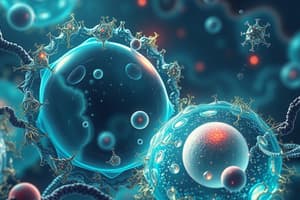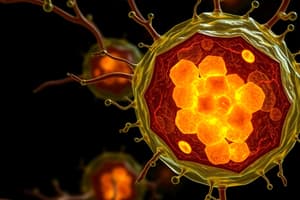Podcast
Questions and Answers
What is the primary function of mitochondria in eukaryotic cells?
What is the primary function of mitochondria in eukaryotic cells?
- Waste breakdown
- Energy production (correct)
- Lipid synthesis
- Protein modification
Which process converts light energy into chemical energy in the form of glucose?
Which process converts light energy into chemical energy in the form of glucose?
- Glycolysis
- Fermentation
- Cellular respiration
- Photosynthesis (correct)
What distinguishes eukaryotic cells from prokaryotic cells?
What distinguishes eukaryotic cells from prokaryotic cells?
- Presence of a nucleus (correct)
- Absence of a cell membrane
- Presence of ribosomes
- Presence of chloroplasts
Which statement accurately describes catabolism?
Which statement accurately describes catabolism?
What role do receptor proteins play in cell communication?
What role do receptor proteins play in cell communication?
During which phase does mitosis ensure identical genetic material is distributed to daughter cells?
During which phase does mitosis ensure identical genetic material is distributed to daughter cells?
What is the primary role of enzymes in metabolic reactions?
What is the primary role of enzymes in metabolic reactions?
What unique structures do plant cells have that contribute to their function in photosynthesis?
What unique structures do plant cells have that contribute to their function in photosynthesis?
Flashcards
Cells
Cells
Fundamental units of life, characterized by a complex organization of structures and functions.
Prokaryotic Cells
Prokaryotic Cells
Cells lacking a nucleus and membrane-bound organelles, found in bacteria.
Eukaryotic Cells
Eukaryotic Cells
Cells possessing a nucleus and membrane-bound organelles, found in plants and animals.
Catabolism
Catabolism
Signup and view all the flashcards
Anabolism
Anabolism
Signup and view all the flashcards
Cellular Respiration
Cellular Respiration
Signup and view all the flashcards
Cell Growth and Division
Cell Growth and Division
Signup and view all the flashcards
DNA
DNA
Signup and view all the flashcards
Study Notes
Cell Structure and Function
- Cells are the fundamental units of life, exhibiting a complex organization of structures and functions.
- Prokaryotic cells lack a nucleus and membrane-bound organelles.
- Eukaryotic cells, present in plants and animals, possess a nucleus and membrane-bound organelles.
- Key organelles include mitochondria (energy production), ribosomes (protein synthesis), endoplasmic reticulum (protein and lipid synthesis), Golgi apparatus (protein modification and sorting), and lysosomes (waste breakdown).
- Plant cells feature chloroplasts (photosynthesis) and a cell wall (structural support).
- The cell membrane regulates substance passage into and out of the cell.
Cell Metabolism
- Metabolism encompasses all chemical reactions within a cell.
- Catabolism breaks down complex molecules into simpler ones, releasing energy.
- Anabolism builds complex molecules from simpler ones, requiring energy.
- Cellular respiration, a crucial catabolic process, generates ATP, the cell's energy currency.
- Photosynthesis, unique to plants, converts light energy into chemical energy (glucose).
- Enzymes accelerate metabolic reactions without being consumed.
Cell Communication
- Cells communicate via various mechanisms, essential for multicellular organism functions.
- Cell signaling involves a cascade of events triggered by external stimuli, leading to specific responses.
- Hormones, neurotransmitters, and other signaling molecules mediate cell communication.
- Various signaling pathways exist, each with unique components and functions.
- Receptor proteins on the cell surface or within the cell receive and transmit signals.
Cell Growth and Division
- Cells grow and divide to maintain tissue and organ integrity.
- The cell cycle encompasses stages from cell division to the next.
- Mitosis is nuclear division, ensuring identical genetic material in daughter cells.
- Meiosis produces haploid gametes, vital for sexual reproduction.
- Growth factors and regulatory proteins control cell cycle progression, preventing uncontrolled growth (cancer).
Genetics and Heredity
- The genetic material is DNA, organized into chromosomes.
- DNA holds the instructions for cell building and operation.
- Genes are DNA segments coding for proteins.
- Gene expression involves DNA transcription into RNA and RNA translation into proteins.
- Inheritance patterns follow predictable principles, including Mendelian genetics.
- DNA mutations cause variations and can lead to traits and diseases.
Studying That Suits You
Use AI to generate personalized quizzes and flashcards to suit your learning preferences.




